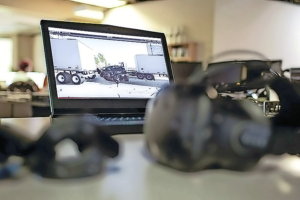The Next Frontier for Virtual Reality: Courtrooms
 Twenty-five years ago, a California jury took a brave leap into the future by donning headsets to watch a virtual reality-like accident reconstruction scene.
Twenty-five years ago, a California jury took a brave leap into the future by donning headsets to watch a virtual reality-like accident reconstruction scene.
The three-dimensional defense presentation lacked interactivity, a current hallmark of virtual reality. But, even so, the presentation helped persuade the jury that a motorcyclist had chosen to ride on dangerous terrain, and that Honda Motor Co. was not responsible for the accident.
Though it can still run into six figures, the cost of virtual reality has come down and tech-savvy attorneys say the time is right for a fresh look at the technology’s use during trials, especially in areas like product liability or criminal law where evidence is vital to recreating events or presenting science.
Virtual reality could be used to “transport members of a jury to a Superfund site, inside a mesothelioma patient’s lungs, to the intersection where an accident occurred, or to a grisly crime scene,” said Edlin, managing partner at Bassi Edlin Huie & Blum in San Francisco.
“I believe that in 10 years, most trial lawyers will be using VR just like they’re using laptops today. VR will be the norm, not the exception,” plaintiffs’ attorney Mitch Jackson, a senior partner at Jackson & Wilson in Laguna Hills, Calif., told Bloomberg Law.
“In some places, it is still hard to use the color red in an illustration out of concern that the court will find it to be overly inflammatory,“ he said. “The use of VR may be adopted in one place quickly and still take years [for adoption] in another.”
Unlike other presentation forms, virtual reality basically embeds jurors at the location where a person was struck and injured by a bus, Edlin said.
These can be depicted in exact detail, “thereby erasing the uncertainty that plagues eyewitness accounts at trial of events long past,” he said.
VR is seen as being particularly useful in science-based litigation, like product liability, intellectual property, and medical malpractice cases. Some even see the immersive VR experience being used as a memory aid in a broader range of cases, both civil and criminal, for witnesses unable to recall events.
“The risks of VR as a memory aid are really no greater than photos, videos or any other type of dramatic evidence that a witness may see,” Lamber and Goodnow said.
But Wiliam & Mary’s Lederer pointed to a downside. He said that “reviving” memory by showing a witness materials with the substantive information clearly runs the risk of the witness testifying to the content of the materials and not an independent memory.
“Arguably, VR might not only accomplish the same thing in a more extreme form but might also implant information,” he said.
The use and widespread adoption of this technology will depend on whether it can be shown that no other media is as effective or “truthful” in showing the substantive aspects of the case, he said.
...VR experts need to be prepared to testify in court regarding the accuracy of the virtual reality model with the judge being the gatekeeper.
These experts will have to not only endure a cross-examination from the opposing lawyer, but they will also have to have their work validated by the judge as worthy of being shown to a jury, they said.
See the full story here: https://biglawbusiness.com/the-next-frontier-for-virtual-reality-courtrooms/
Pages
- About Philip Lelyveld
- Mark and Addie Lelyveld Biographies
- Presentations and articles
- Tufts Alumni Bio